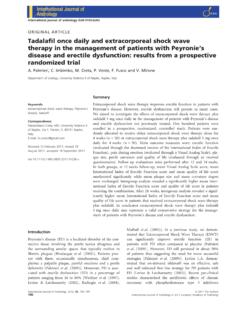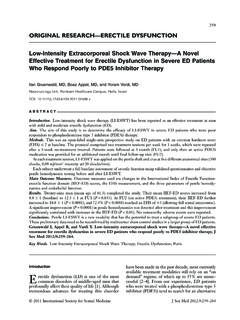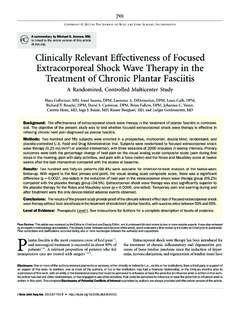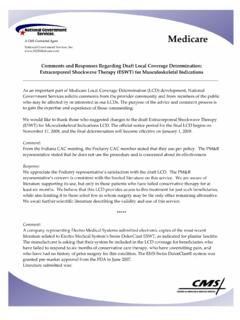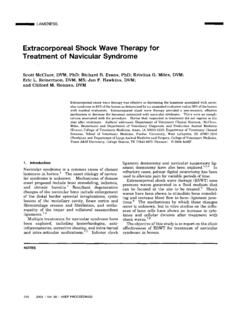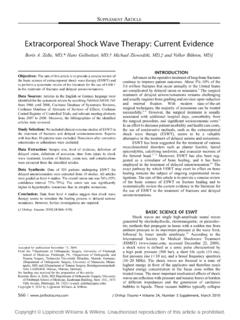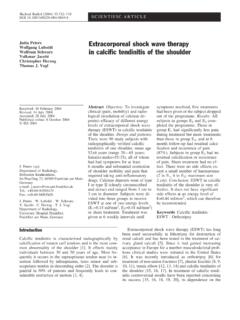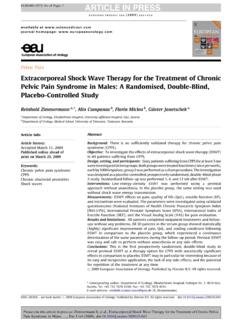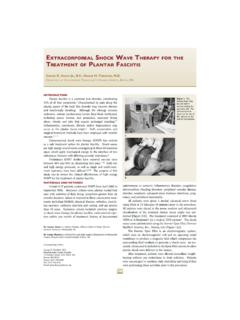Transcription of Extracorporeal Shock Wave Therapy (ESWT)
1 Extracorporeal Shock Wave Therapy (ESWT)Jenna Veens, MPT 2015 Western University What is it? Extracorporeal = outside body1 shockwave = intense, short energy wave travelling faster than speed of sound1 Well-controlled mechanical insult to tissue2 ESWT was established based on the principles of lithotripsy1 Technology that uses acoustic sound waves to break up kidney stones How Does It Work? Mechanical pressure increases cell membrane permeability1 Acoustic waves cause small capillaries in tissue to rupture, which increases growth factors to the area3 How Does It Work? Neovascularizationor new blood supply1,3 More blood = more oxygen = better healing Stimulates fibroblasts for connective tissue healing1,3 Tendon, ligament, fasciaHow Does It Work?
2 Stimulates osteoblastsfor healing and new bone production1 Destroys calcifications3,4 How Does It Work? Decreases pain Hyperstimulationanesthesia1,4,5,6 Reduces effects of Substance P neurotransmitter3 Gate-control theory1,5,6 Gate Control TheorySG = SubstantiaGelatinosa Activation of A-Beta fibers inhibit transmission of pain signals to brain5,6 Types2 Electrohydraulic Electromagnetic Piezoelectric Radial or Electro-pneumatic Requires noimaging or additionaltreatments such asultrasound or localanesthetic5(Graph from DJO Global, 2012)Mechanics5 Radial wave pulses are produced by compressed air in the cylinder of the hand piece A projectile in the hand piece generates kinetic energy This kinetic energy is transferred into acoustic energy which is sent into nearby tissues Depth of energy penetration is approximately 0-6 cmTerminology Energy Flux Density7 Degree of energy transmitted to the tissues Low (< mJ/mm2) Medium ( to mJ/mm2) High ( to )
3 Pulses Per Dose7 Ranges from 1000 to 3000 Several doses may be given over course of a treatment Conditions Treated with ESWT Plantar Fasciitis Achilles Tendinopathy Epicondylitis CalcificTendinopathyof the Shoulder Patellar Tendinopathy Post-Traumatic MyositisOssificans Non-Union Fractures Trigger Points Frozen Shoulder Dupuytren sContracture DeQuervainSyndrome And : CalcificTendinopathy High-Energy Extracorporeal Shock -Wave Therapy for Treating Chronic CalcificTendinitis of the Shoulder7 Systematic review Results: high energy ESWT was effective for treating calcifictendinitis Reduced pain, improved function, resorptionof calcifications Low energy ESWT is less effective Regardless of energy level, ESWT is not effective in treating non-calcifictendinitis(Bannuruet al.)
4 , 2014)Evidence: Plantar Fasciitis Extracorporeal shockwave Therapy versus placebo for treatment of chronic proximal plantar fasciitis: results of a randomized, placebo-controlled, double-blinded, multicenter intervention trial8 Single treatment of EWST (n=115) vs. placebo (n=57) with 3 month to 1 year follow-up All patients had previously failed at least 2 pharmacologic treatments AND at least 2 non-pharmacologic treatments No use of corticosteroid injections, NSAIDs, or physical Therapy during study (Malay et al., 2006)Evidence: Plantar Fasciitis Outcome Measures Blind assessor s objective assessment of heel pain Participant s subjective assessment of heel pain (VAS) Results Significantly greater reduction of objective heel pain in treatment group (mean of ) vs.
5 Placebo group (mean of ) (P< ) Significantly greater reduction of subjective heel pain in treatment group (mean of ) vs. placebo group (mean of ) (P< ) Conclusion Effective for heel pain reduction in patients with recalcitrant plantar fasciitis (Malay et al., 2006)Evidence: Plantar Fasciitis Extracorporeal Shock wave for chronic proximal plantar fasciitis: 225 patients with results and outcome predictors9 Retrospective study All subjects had plantar fasciitis > 6 months with failure to respond to at least 5 conservative modalities Multivariate analysis performed to determine outcome predictors (Chuckpaiwong, Berkson& Theodore, 2009)Evidence.
6 Plantar Fasciitis Outcome Measures Health questionnaire, Roles and Maudsleyscores, American Orthopaedic Foot and Ankle Society scores Results Success rates of at 3 months and at 12 months Previous cortisone injections, BMI, duration of symptoms, bilateral symptoms, and plantar fascia thickness did NOT influence outcomes Diabetes, psychological issues, and older age NEGATIVELY influenced outcomes (Chuckpaiwong, Berkson& Theodore, 2009)Evidence: Achilles Tendinopathy The effectiveness of Extracorporeal Shock wave Therapy in lower limb tendinopathy: a systematic review10 11 studies reviewed ESWT produces greater short-term and long-term improvements in pain function compared to other non-operative treatments (rest, footwear modification, NSAIDs, stretching, or strengthening) One study demonstrated that eccentric loading with ESWT is superior to eccentric loading alone Greater improvements in pain and function (Mani-Babuet al.)
7 , 2014)Evidence: Patellar Tendinopathy The effectiveness of Extracorporeal Shock wave Therapy in lower limb tendinopathy: a systematic review10 7 studies reviewed, mixed results One study showed no difference between ESWT and placebo Two long-term studies showed ESWT to be comparable with patellar tenotomysurgery and better than non-operative treatments (NSAIDs, physical Therapy , exercise, knee strap, and modification of activity) Greater improvements in pain and function (Mani-Babuet al., 2014)Evidence: Epicondylitis Systematic review of the efficacy and safety of Shock wave Therapy for lateral elbow pain11 9 placebo-controlled trials + 1 ESWT vs.
8 Steroid injection Conflicting results Three trials in favour of ESWT, four trials reported no benefit Steroid injection more effective than ESWT ESWT provides little or no benefits in terms of pain and function in lateral elbow pain (Buchbinderet al., 2006)Parameters No consensus in literature See Chattanooga Guidelines5Is It Safe?5 Mild side effects reported in studies Side effects usually come and go within 3 to 5 days Redness Swelling Pain Hematoma Petechiae(red spots)Contraindications4 Bleeding conditions Pacemakers Medications that prolong blood clotting Open growth plates (children) Pregnancy Acute injuriesConclusions EWST is often a last resort treatment once other less expensive treatments have failed (ie.)
9 Manual Therapy , U/S) Best results when used in conjunction with exercise Not a stand-alone modality! Positive findings for plantar fasciitis, patellar tendinopathy, and Achilles tendinopathy Mixed results for calcifictendinopathyof the shoulder and lateral Therapy BC. ( ). General information about Extracorporeal shockwave from #How_effective_is_Focused_ESWT_0 , J. (2013). shockwave Therapy for treatment of chronic soft-tissue lesions: an emerging technology worth a close look. Physical Therapy Products, 24(2), (2014). Medical effects. Retrieved from , & Michlovitz, (2012). Alternative modalities for pain and tissue healing.
10 Modalities for therapeutic intervention, 5thed(389-402). Davis Global. (2012). Chattanooga RPW shockwave Therapy clinical guide. Retrieved from derWorp, H., van den Akker-Scheek, I., van Schie, H., Zwerver, J. (2013). ESWT for tendinopathy: technology and clinical implications. Knee SurgSports TraumatolArthrosc, 21,1451-1458. , R., Flavin, N., Vaysbrot, E., Harvey, E., McAlindon, T. (2014). High-energy Extracorporeal Shock -wave Therapy for treating chronic calcifictendinitis of the shoulder. Annals of Internal Medicine, 160, , D., Pressman, M., Assili, A., Kline, J., York, S., Buren, B., Heyman, E., Borowsky, P., LeMay, C. (2006).
